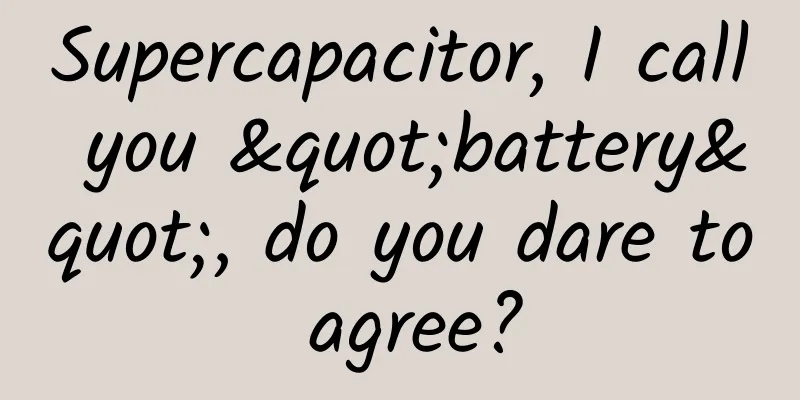Supercapacitor, I call you "battery", do you dare to agree?

|
Batteries are everywhere in our lives, but capacitors and supercapacitors may be unfamiliar to many readers. In fact, both batteries and capacitors have extensive and important applications in production and life, and both are typical representatives of chemical storage of electrical energy and physical storage of electrical energy; supercapacitors, in particular, combine the characteristics of capacitors and batteries, and absorb both in principle, becoming a type of electrochemical device with unique properties and wide application. With the development of chemistry, physics and materials science, the boundary between chemical and physical storage of electricity is becoming increasingly blurred. Batteries, capacitors and supercapacitors are taking the essence of each other in order to better meet human needs and serve social development. Written by Li Cunpu (Professor of College of Chemistry and Chemical Engineering, Chongqing University) 01 Understanding the storage of electrical energy The development and application of electric energy is the key to human modernization, which has brought human energy utilization to a new level. Electric lights, telegraphs, electronic computers, mobile communication devices, modern human needs and applications for electric energy are changing with each passing day. In power plants, electric energy is generated by heat energy, mechanical energy, solar energy, wind energy and other energy sources, and transmitted to electricity users through the power grid. It does not rely on special working substances (working fluids) to be transmitted and used. This feature is the key to its widespread application, but it is also an obstacle to its storage. In addition to the production and transmission of electric energy, its efficient storage and release are currently important concerns of academia and industry. There are many purposes for the development of electric energy storage, but in the final analysis there are only two purposes: one is to regulate and connect to the grid at the upstream production end, and the other is to use it off the grid at the downstream user end. For the upstream production end of electric energy, wind energy, solar energy, etc. can only supply electricity intermittently, which is in natural contradiction with the stable demand for power supply from the power grid. Electric energy needs to be stored and released to achieve a balance between supply and demand. For the downstream user end, although electric energy can now be transmitted to thousands of households, on the one hand, there is also a natural contradiction between the peak and valley imbalance of electricity consumption and the stable supply of electricity; on the other hand, the electricity demand that is off the grid, such as electric vehicles, outdoor electricity, and mobile communication equipment, all requires the storage and release of electric energy. Unfortunately, the transmission and use of electrical energy do not require working fluids, which makes it difficult for us to find suitable objects or devices to store electrical energy directly. Superconductivity may be the ultimate solution to the problem, directly storing the important carrier of electrical energy - electrons - in superconducting devices without hindrance. However, due to the fact that superconducting devices require a low-temperature environment, the electrical energy consumed in the cooling process is far greater than the energy stored in the superconducting device. Therefore, before room-temperature superconductivity is actually used, the most economical option is to develop energy storage devices. When we consider electrical energy storage devices, the most essential requirement is how much energy can be stored/released. Taking basic direct current as an example, in junior high school physics we have already mastered the basic formula for calculating the amount of electrical energy: Where ΔU is the amount of electrical energy stored/released/transferred (in joules), ΔV is the potential difference or voltage between the positive and negative electrodes of the electrical energy (in volts), and Q is the amount of electricity stored/released/transferred (in coulombs). When the transmission of electrical energy is constant voltage and constant current, Q is equal to the current (in amperes) multiplied by the time t. Of course, this article is not intended to discuss the electrical part of junior high school physics, but the above formula (1) can help us understand what we need to do when we want to store electrical energy: increase the voltage ΔV and increase the amount of electricity stored Q. 02 Chemical power batteries and physical power capacitors Currently, the two mainstream ways of storing electrical energy are batteries and capacitors (and supercapacitors), which are also representative devices for chemical storage of electrical energy and physical storage of electrical energy, respectively. Figure 1 Schematic diagram of the structure and principle of batteries and capacitors. The diagram shows the device in discharge state. 2.1 Chemical power source - battery Batteries are currently the most widely used electrical energy storage and conversion devices. The principle is to design a chemical reaction that is spontaneous ( ΔG < 0 ) and involves electron transfer , physically isolate the oxidation and reduction half-reactions, guide electrons to migrate through the external circuit to release electrical energy, and at the same time, the internal circuit ions migrate to complete the reaction loop. The above process directly converts free energy into electrical energy: Where ΔG is the Gibbs free energy of the reaction (also the opposite of the amount of electrical energy that can be stored, ΔU; the unit is kilojoules/mole), n is the number of electrons transferred in the chemical reaction, F is the Faraday constant, and ΔV is the potential difference (voltage) of the reaction. Compared to the power generation process of chemical combustion to generate heat energy - heat energy drives the piston to do work and is converted into mechanical energy - mechanical energy is converted into electrical energy, the energy storage battery avoids the theoretical efficiency limit of the Carnot cycle for the efficiency of converting thermal energy to chemical energy, and there is no heat generation efficiency loss in the conversion of mechanical energy to electrical energy, so it has the highest theoretical conversion efficiency of chemical energy to electrical energy. As shown in the left figure of Figure 1, taking the widely used lithium-ion battery as an example, when the battery is in the discharge state, the electrons in the external circuit start from the negative electrode, pass through the electrical appliance to the positive electrode; the positive electrode material obtains electrons to undergo a reduction reaction, and the lithium ions are embedded in the positive electrode material to ensure that the positive electrode material is not charged. The negative electrode material loses electrons and undergoes an oxidation reaction, and the lithium ions leave the negative electrode and enter the electrolyte solution. Due to the gain and loss of electrons at the positive and negative electrodes, accompanied by the gain and loss of positively charged lithium ions, the positive and negative electrodes of the battery do not carry any charge when in operation, and the voltage of the released electrical energy comes from the difference in chemical potential of the positive and negative electrode materials. In lithium-ion batteries, lithium ions do not directly gain or lose electrons, but complete the charging and discharging process through the embedding/de-embedding of lithium ions. When the battery is working, the structure of the solid positive and negative electrode materials is stable, and the lithium ion concentration of the electrolyte remains stable, which makes the battery operating voltage stable, which is the key to the commercial success of lithium-ion batteries. 2.2 Physical Power Supply - Capacitor Compared to batteries, which are chemical power sources that use chemical reactions to store electrical energy, the principle of capacitors is more direct. Let us go back to the lesson on flat capacitors in high school physics class. As shown in the figure in Figure 1, no chemical reaction occurs during the operation of the capacitor. The surface of the negative electrode material of the charged capacitor carries excess electrons, and the corresponding number of positive charges of these electrons are stored on the surface of the positive electrode material. When the capacitor is discharged, the excess electrons at the negative electrode reach the positive electrode through the electrical appliance, neutralizing the positive charge carried by the positive electrode, and at the same time, the negative electrode material returns to electrical neutrality. For flat plate capacitors, the stored charge and energy can be processed using formulas (3) and (4): Where Q is the amount of charge stored in the capacitor, ΔV is the voltage of the capacitor, and C is the capacitance of the capacitor. It can be found that the capacitance C of the capacitor is related to the material and structure of the capacitor, and the key physical quantity of the material is the dielectric constant ε: In formula (5), S is the electrode area of the flat plate capacitor, d is the distance between the flat plates, and ε is the dielectric constant of the dielectric between the capacitor electrodes. The dielectric is a type of non-conductive material that has a certain polarity. When an external electric field is applied, it will be oriented by the electric field lines to form a reverse electric field in the opposite direction of the external electric field. The stronger the reverse electric field formed by the dielectric, the more charge the positive and negative plates of the capacitor need to accumulate to offset it, thereby improving the capacitor's ability to store charge - that is, improving the capacitor's ability to store electricity. 2.3 Batteries vs. Capacitors When we compare the power storage principles of batteries and capacitors, we can find their respective characteristics determined by their principles: batteries have large power storage capacity, a stable discharge platform, and a long storage time, but a slow charging/discharging speed; capacitors have small power storage capacity, an unstable discharge platform, and a short storage time, but a fast charging/discharging speed. In order to understand the difference between batteries and capacitors, we might as well focus on what goals they achieve when they are charged. As shown in the left figure of Figure 2, when the battery is charged, the negative electrode of the charger is connected to the negative electrode of the battery. Since the reducibility (ability to give electrons) of the negative electrode of the charger is stronger than that of the negative electrode material of the battery, in line with the principle of "the weak ones will be beaten", the negative electrode material of the battery will obtain electrons for reduction reaction; at the same time, in order to ensure the electrical neutrality of the material, positively charged cations will enter the negative electrode material to form the charging product of the negative electrode of the battery. The positive electrode of the battery reacts similarly to the negative electrode when charging. Since the battery uses the redox reaction of a large amount of materials in the electrode to store electrical energy, its charge storage capacity is large. For example, lithium-ion batteries can reach an energy density of 300Wh/kg (electrical energy stored per unit weight, that is, 0.3 kWh of electricity is stored per kilogram of battery). Correspondingly, due to the dependence on the redox reaction of the electrode material, the positive and negative electrode materials of the battery are often non-excellent conductors such as oxides, carbon materials, and nitrides. In addition, the speed of chemical reactions and the migration speed of ions in the electrode material are slow, so the charging and discharging speed of the battery is slower than that of the capacitor. After the battery is fully charged and the charger is disconnected, there is no electric field inside the battery because the positive and negative electrodes of the battery are electrically neutral, and the battery can be stored for a long time. Figure 2 Schematic diagram of battery and capacitor charging targets and processes As for capacitors, as shown in the right figure of Figure 2, the positive and negative electrodes of capacitors are both conductors. Therefore, when the capacitor is connected to a charger, the negative electrode of the capacitor will gain electrons, with the goal of forming an equipotential body with the negative electrode of the charger (an inherent property of the conductor); similarly, the electrons at the positive electrode of the capacitor will be removed until the potential is equal to that of the positive electrode of the charger. In this process, the electrons are actually transferred from the positive electrode of the capacitor to the negative electrode through the charger, and the ultimate goal is for the positive and negative electrodes of the capacitor to form an equipotential body with the positive and negative electrodes of the charger respectively - a 5V charger will naturally charge the capacitor to 5V. But how much charge is transferred between the positive and negative electrodes (or how many electrons are accumulated at the negative electrode) depends on the dielectric inside the capacitor. Taking the charging of a 5V charger as an example, as the charges of the positive and negative electrodes accumulate, an electric field is generated inside the capacitor. The electric field strength E multiplied by the distance d between the positive and negative electrodes is the potential difference ΔV of the capacitor. The goal of charging is very clear, that is, the potential difference between the positive and negative electrodes reaches 5V. However, since the polarity of the dielectric will generate a reverse electric field, it will weaken the internal electric field E of the capacitor. Therefore, the positive and negative plates need to accumulate more charge and increase the electric field E to achieve the goal of ΔV=5V. The stronger the ability of the electrolyte to generate a reverse electric field, the more charge the capacitor can store, that is, the more energy. According to the characteristics of conductor equipotential bodies, the positive and negative plates of capacitors can only store charges on the electrode surface, and the naturally stored energy is very small (generally less than 10 Wh/kg). However, from the perspective of charging and discharging speed, the transmission speed of electrons in conductors is extremely fast, so capacitors that store electrical energy based on physical principles have better charging and discharging speeds, and the charging and discharging power is much greater than that of batteries. (Although the capacity of capacitors is low, the time taken to fully charge is in milliseconds, while super-fast charging of batteries also takes 20 to 30 minutes, that is, the charging speed of capacitors is 1 million times that of batteries.) In addition, since the capacitor plates carry charges after being fully charged, and there is an electric field inside, that is, the capacitor is in an "unstable" state after being fully charged, so during the placement process, the capacitor will self-discharge (leakage) at a faster rate, and cannot be stored for a long time like a battery. 03 Supercapacitors As mentioned earlier, batteries use chemical reactions to store energy, storing a lot but slowly; capacitors use physical principles to store charges, storing charges quickly but in small amounts. So is it possible to combine the characteristics of both to develop an energy storage device that is both fast and good? Supercapacitors may be a good entry point. From the name, supercapacitors seem to be just the pro max version of capacitors, but in fact, the "super" in supercapacitors is not a simple upgraded version of capacitors, but a type of device that comprehensively utilizes the principles of batteries and capacitors. For capacitors, the principle of physical power storage can achieve rapid charging and discharging of the device, that is, meet the high power requirements from a practical perspective. Looking back at the previous formula (5), due to the structural limitations of the capacitor, the improvement from the structural perspective is mainly achieved by reducing the distance d between the positive and negative electrodes, but if the distance is too small, short circuits are likely to occur, causing capacitor failure; and from the material perspective, the capacity improvement is mainly achieved by increasing the dielectric constant of the dielectric, but due to the molecular characteristics of the dielectric, the reverse electric field that it can provide is very limited, which limits the leapfrog improvement of the capacitor capacity. The characteristic of supercapacitors (hereinafter referred to as "supercapacitors") is that they use electrolytes containing anions and cations similar to batteries to replace the dielectrics in traditional capacitors, which can greatly reduce d (from 1mm to 1nm, a reduction of 10-6 times; imagine that your loan becomes one millionth of what it is now, it is so super) and greatly increase the electrode area S (imagine that your salary increases by 1 million times, it is so super). As shown in Figure 3, when the supercapacitor is fully charged, the negative electrode will carry negative charge and the positive electrode will carry positive charge. However, unlike capacitors, the interior of supercapacitors is no longer a dielectric molecule that can only rotate in a certain direction and polarize to generate a reverse electric field, but an electrolyte with anions and cations. Therefore, the cations in the electrolyte will gather on the negative electrode side and form a "double layer" with the negative electrode plate; similarly, the anions will migrate to the positive electrode side and form a "double layer" with the positive electrode plate [1-2] . Figure 3 The left figure is a schematic diagram of the supercapacitor structure, showing the device in discharge state. The right figure shows a method for increasing the specific surface area of the electrode [3] Each double electric layer can be regarded as the "capacitance" formed between the migrating ions and the electrodes. Since the distance between the ions and the electrodes is very close (nm scale), the d in formula (5) is greatly reduced. At the same time, by constructing porous, core-shell and other electrode material structures, the specific surface area of the electrode material can be greatly increased, achieving a leapfrog increase in S. Therefore, when S increases and d decreases, the C of the supercapacitor can naturally achieve a leapfrog increase. Figure 4 The double-layer principle of supercapacitors and three common types of pseudocapacitors [4] In addition to using electrolytes to replace dielectrics to achieve a "super" effect using the double electric layer, the "pseudocapacitor" strategy is also an important method for supercapacitors to further increase their capacity. "Pseudo", as the name implies, is fake. It does not really use the charge accumulation-double monolayer principle to store charge, but has similar characteristics to capacitors. "Pseudocapacitors" include three common principles, such as the low potential opportunity strategy, which is to adsorb some ions to the electrode surface at a lower potential for reduction to provide additional charge accumulation; the most widely used is to use the redox reaction at the electrode interface to store additional electrical energy, rather than relying solely on physical charge accumulation. For example, electrode materials such as ruthenium dioxide and manganese dioxide, ruthenium and manganese elements can achieve valence changes by gaining and losing electrons, thereby allowing the surface of the material to carry additional charge, achieving the effect of greatly increasing capacity. In addition, there are also ion intercalation methods similar to the principles of lithium-ion batteries to store additional charge to the electrode. It can be found that the above pseudocapacitor strategies all use additional chemical reactions to enhance the ability of supercapacitors to store charge, making supercapacitors a representative device for storing energy through the comprehensive physical and chemical principles. At present, the energy density of supercapacitors can reach 40 Wh/kg, which has exceeded that of lead-acid batteries. Although there is still a big gap compared with lithium-ion batteries (lithium-ion batteries can reach 300 Wh/kg), supercapacitors have been widely used in today's production and life because they combine the characteristics of batteries and capacitors and have unique advantages in fast charging and discharging: for example, Shanghai's No. 930 bus uses supercapacitors as power supply devices. The car quickly replenishes the power when it stops at the station to pick up and drop off passengers, and then can easily use the supplementary power to drive to the next station to continue replenishing the power. Since it does not involve the charging process at the charging station, the car has high operating efficiency and avoids the potential safety issues of lithium-ion batteries. Thanks to the high power characteristics of supercapacitors, it can combine with lithium-ion batteries to have both capacity and power advantages, and is gradually used in the fields of power grid peak regulation, energy storage, and car starting. I believe that supercapacitors will soon be seen on consumer electronic devices in the future: whether it is a camera flash or the strong vibration of the game controller when commanding the battle of the destiny man, the high power characteristics of supercapacitors can give users a more intimate experience. Conclusion Whether it is batteries, capacitors or supercapacitors, they all come from scientists' continuous exploration, thinking and attempts at energy storage methods. We also find that with the continuous development of science and technology, the boundaries of physics and chemistry for energy storage have long been blurred. Comprehensively utilizing knowledge from various disciplines to help humans develop better energy storage devices is the direction of continuous efforts by the academic community and the only way to meet the people's growing energy needs. Sun Wukong holding a "supercapacitor" References [1] JM Crow, Fast charging supercapacitors, Chemistry World [2] Chem. Rev. 2022, 122, 12, 10821–10859. [3] Chem. Soc. Rev., 2014, 43, 3303. [4] Chem. Rev. 2018, 118, 18, 9233–9280. Special Tips 1. Go to the "Featured Column" at the bottom of the menu of the "Fanpu" WeChat public account to read a series of popular science articles on different topics. 2. Fanpu provides a function to search articles by month. Follow the official account and reply with the four-digit year + month, such as "1903", to get the article index for March 2019, and so on. Copyright statement: Personal forwarding is welcome. Any form of media or organization is not allowed to reprint or excerpt without authorization. For reprint authorization, please contact the backstage of the "Fanpu" WeChat public account. |
Recommend
What are some confusing design rules in iOS?
Although iOS's experience design is generally...
The elderly have become the biggest victims of the Internet age! Who will deal with the chaos of big data?
Every year, March 15 brings us many unexpected th...
More painful than a burn or a needle prick? More and more people are suffering from shingles...
Some people can't sleep in the middle of the ...
What should I do at work tomorrow?
The holiday is over and we will go back to work t...
Five major trends in digital marketing in 2021
If I were to summarize the marketing trends in 20...
World Whale Shark Day | The emotionally stable "cute baby" in the sea, is he a whale or a shark?
Xu Huangang With its charming appearance, unique ...
Weibo Brand Account Private Domain Marketing Skills
In the era of mobile Internet, traffic, that is, ...
It invades fishing grounds on a large scale and preys on shellfish. What is this "killer"?
Review expert: Ancient Mingdi Lian (He Lin) Zhihu...
Italy has 3526 new deaths and 345 deaths, with a total of 2503 deaths
According to the latest news from the Dutch media...
5 steps to quickly get started with Weibo channel operations!
As the gossip center of the entire Internet, Weib...
This is the "super group"! Those young scientists who are "entangled" with quantum
Xinhua News Agency, Hefei, May 3, Title: This is ...
Can humans really achieve immortality? Let's start with HeLa cells
"Eternal life" has always been an impor...
Is dandruff just caused by insufficient cleaning?
This article was reviewed by: Xiaobo Zhou, Doctor...
How to operate the WeChat official account new media of Internet finance products?
As we all know, various Internet products are now...
Information flow advertising | How to increase click-through rate through simple changes in text?
For information flow advertising , " copywri...









